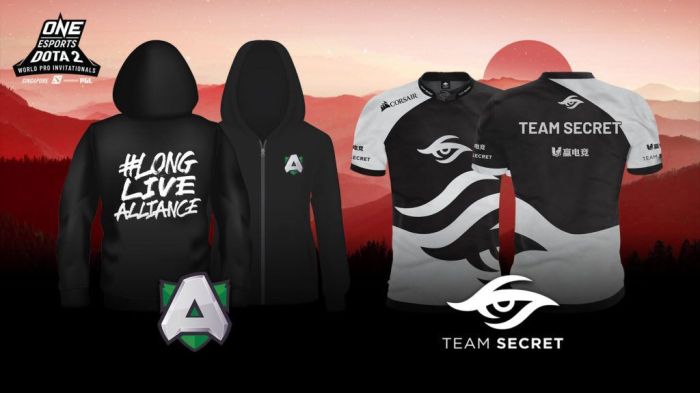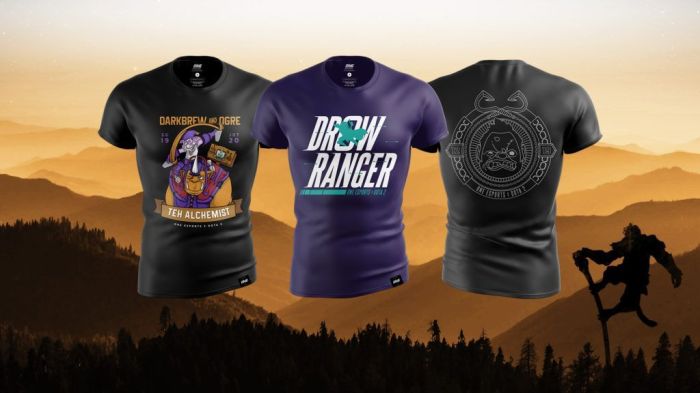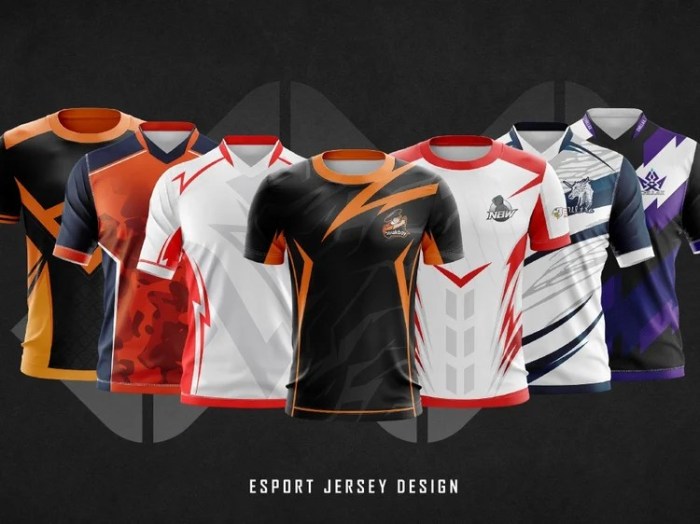Esports merchandise is blowing up! It’s not just jerseys anymore; we’re talking everything from limited-edition figurines to custom-designed gaming peripherals. This market is huge, driven by passionate fans who want to rep their favorite teams and players. Think about the insane hype around a new skin release or a championship-winning team’s merch – that’s the power we’re talking about.
This deep dive explores the current state of the esports merchandise market, from its size and growth to the various types of merchandise available and the strategies used to sell them. We’ll look at the key players, marketing tactics, and future trends shaping this exciting industry. Get ready to level up your understanding of esports merch!
Impact of Esports Events and Teams

Esports events and the teams participating in them are massive drivers of merchandise sales. The energy and excitement surrounding these competitions create a highly engaged audience eager to show their support for their favorite players and teams. This enthusiasm translates directly into a significant market for branded apparel, collectibles, and other merchandise. The relationship between esports events, teams, and merchandise sales is complex and multifaceted, influenced by various factors we’ll explore below.Major esports events significantly boost merchandise sales.
The increased visibility and media attention surrounding these tournaments expose a wider audience to the teams and players, generating a surge in demand for associated merchandise. The heightened emotional investment during these events, fueled by intense competition and dramatic moments, translates into impulsive purchases and a greater willingness to spend on branded items. Think of the League of Legends World Championship – the sheer scale of the event and the global viewership lead to a massive spike in sales for Riot Games’ merchandise and that of participating teams.
The limited-edition items released around these events often become highly sought-after collector’s pieces, further driving sales.
Esports Team Merchandise Offerings
Esports teams understand the value of merchandise as a crucial revenue stream and a powerful tool for fan engagement. They offer a wide range of products, from jerseys and hoodies to mousepads and keychains, catering to diverse fan preferences and price points. Team branding is carefully integrated into all merchandise, reinforcing team identity and creating a strong visual connection with the fans.
The merchandise itself often incorporates elements of the team’s logo, colors, and mascots, creating a consistent and recognizable brand image across all products. This strategy allows fans to express their team loyalty and support in a tangible way, increasing brand recognition and strengthening the connection between the team and its fanbase. Many teams also release limited-edition merchandise tied to specific events or victories, creating scarcity and further driving demand.
Impact of Team Branding and Player Endorsements
Team branding plays a critical role in merchandise sales. A strong, well-defined brand identity creates a sense of community and belonging among fans. Consistent use of logos, colors, and fonts across all merchandise reinforces this brand identity and makes the products instantly recognizable. Effective branding builds trust and loyalty, making fans more likely to purchase merchandise. Player endorsements further amplify the impact.
Popular players, particularly those with a large and dedicated fanbase, can significantly boost sales by endorsing specific merchandise items. Their association with the product lends credibility and desirability, making it more attractive to fans who admire their skills and personality. Think of a popular streamer or pro player endorsing a specific gaming chair or headset – their endorsement can dramatically increase sales.
Successful Merchandise Collaborations
Successful collaborations between esports teams and brands expand market reach and introduce new audiences to both parties. For example, a partnership between a popular esports team and a clothing brand could result in a limited-edition clothing line featuring the team’s logo and branding. This expands the team’s reach beyond its core fanbase by tapping into the established customer base of the clothing brand.
Similarly, a collaboration with a gaming peripheral manufacturer could lead to the creation of co-branded headsets or keyboards, offering fans high-quality products bearing their favorite team’s branding. These collaborations create win-win situations, generating additional revenue for both parties while offering fans unique and desirable merchandise. The success of these collaborations hinges on choosing complementary brands that align with the team’s values and target audience.
A well-executed collaboration can significantly boost brand awareness and merchandise sales for both parties involved.
Future Trends in Esports Merchandise

The esports merchandise market is constantly evolving, driven by technological advancements and the ever-growing popularity of competitive gaming. We’re seeing a shift beyond basic team jerseys and hoodies towards more personalized, technologically integrated, and sustainable products. This trend is fueled by both the demands of a sophisticated fanbase and the innovative capabilities of brands and manufacturers.Esports Merchandise Design and Production AdvancementsThe future of esports merchandise will likely see a significant increase in personalization and customization.
Fans will have more opportunities to design their own merchandise, incorporating their favorite team logos, player names, and even personalized artwork. This could involve online design tools integrated with 3D printing or on-demand manufacturing, allowing for rapid production of unique items. Sustainable and ethically sourced materials will also become increasingly important, reflecting a growing consumer awareness of environmental and social responsibility.
We can expect to see more brands using recycled fabrics, eco-friendly dyes, and transparent supply chains. For example, a popular team could partner with a sustainable clothing brand to release a limited-edition line of apparel made from recycled materials, promoting both their brand and their commitment to environmental consciousness.
The Impact of New Technologies
NFTs (Non-Fungible Tokens) and AR/VR (Augmented and Virtual Reality) technologies are poised to revolutionize the esports merchandise market. NFTs can be used to create unique, digitally scarce items, such as virtual skins for in-game avatars or digital collectibles featuring players or team logos. These NFTs can be linked to physical merchandise, creating a hybrid experience that blends the digital and physical worlds.
AR/VR could allow fans to virtually try on merchandise before purchasing it, enhancing the online shopping experience and reducing returns. Imagine an app that allows fans to virtually “wear” a jersey using their smartphone’s camera, seeing how it looks on them before making a purchase. Furthermore, AR experiences could unlock exclusive content or rewards when interacting with physical merchandise, deepening the connection between fans and their favorite teams or players.
Growth in Niche Esports Merchandise Markets
Niche esports merchandise markets are showing significant potential for growth. This includes merchandise tailored to specific games, characters, or even individual players. For example, a highly skilled player might release their own line of merchandise featuring their unique in-game avatar or signature style. Similarly, merchandise based on specific esports events, like limited-edition championship gear, will continue to be highly sought after.
The success of these niche markets relies on understanding and catering to the specific preferences and interests of individual fan bases within the larger esports community. Think of a collectible figurine of a popular character from a battle royale game, meticulously detailed and packaged in a premium box – a highly desirable item for dedicated fans.
Visual Representation of Future Trends
Imagine a holographic display in an esports arena showcasing a new line of team merchandise. The display features interactive elements, allowing fans to zoom in on individual items and see detailed 3D models. One item displayed is a sustainable, personalized jersey made from recycled materials, featuring a unique design created by a fan using an online design tool.
Next to it is a sleek, minimalist headset with integrated AR capabilities, allowing the wearer to overlay game-related information onto their real-world view. Finally, a display case showcases a limited-edition NFT collectible linked to a physical keychain featuring a popular player’s signature. The entire display is sleek and modern, reflecting the high-tech nature of esports and its fanbase.
Marketing and Promotion Strategies

Effective marketing is crucial for any esports merchandise business to thrive. Reaching the right audience with the right message, at the right time, is key to driving sales and building brand loyalty within the competitive esports landscape. This requires a multi-faceted approach leveraging various channels and strategies.
Social Media Marketing and Influencer Collaborations
Social media platforms like Twitch, Twitter, Instagram, and TikTok are essential for reaching esports fans. Targeted advertising campaigns on these platforms allow for precise audience segmentation based on demographics, interests, and gaming habits. For example, an ad for a new team jersey could be specifically targeted at fans of a particular game or team, maximizing its impact. Influencer marketing plays a vital role; partnering with popular streamers or esports personalities to promote merchandise can significantly boost brand awareness and drive sales.
Imagine a top streamer showcasing a limited-edition mousepad during a live stream – the potential for immediate sales is enormous. This type of authentic endorsement holds significant weight with the target audience.
Promotional Campaigns and Special Offers
Strategic promotional campaigns and special offers are powerful tools for increasing merchandise sales. Limited-edition releases, exclusive bundles, and seasonal discounts can create a sense of urgency and encourage impulse purchases. For instance, releasing a special championship-themed hoodie only available for a limited time after a major tournament victory can generate significant excitement and demand. Similarly, offering discounts during major gaming conventions or holiday periods can boost sales considerably.
Contests and giveaways, offering merchandise as prizes, also effectively engage the community and increase brand visibility.
Marketing Channels and Target Audiences, Esports merchandise
Different marketing channels cater to different segments of the esports audience. While social media is effective for reaching a broad audience, email marketing allows for more personalized communication with loyal customers, offering exclusive deals and updates. Sponsorships of esports events and tournaments provide valuable brand exposure to a large, engaged audience. Collaborations with esports organizations and teams can further extend reach and build trust within specific communities.
For example, a partnership with a popular esports team could lead to the team’s players wearing and promoting the merchandise, creating a powerful endorsement. Each channel needs to be carefully considered to maximize its effectiveness for the specific target audience.
FAQ: Esports Merchandise
What are some examples of niche esports merchandise?
Think limited edition signed items, high-end collectibles, or even custom-designed furniture with team logos. The sky’s the limit!
How do I start selling my own esports merchandise?
You’ll need designs, a platform (Etsy, Shopify, etc.), and a marketing plan. Consider licensing if you’re using team logos. It’s a competitive market, so stand out!
What’s the difference between esports merchandise and regular sports merchandise?
Esports merch often leans more towards digital and gaming-centric designs. It also integrates more heavily with digital platforms and social media marketing strategies.
How do I know if my esports merchandise idea is viable?
Market research is key! Look at existing merch, check out social media trends, and consider your target audience’s preferences. A solid business plan is also essential.
